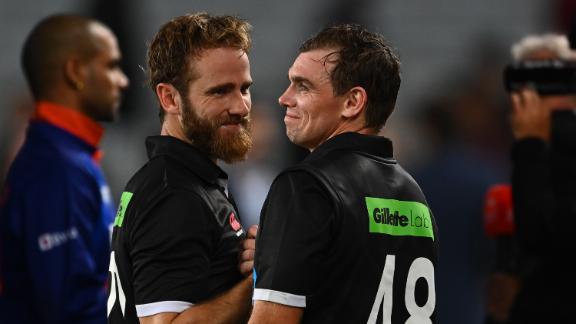New Zealand 309 for 3 (Latham 145*, Williamson 94*, Malik 2-66) beat India 306 for 7 (Iyer 80, Dhawan 72, Gill 50, Ferguson 3-59, Southee 3-73) by seven wickets
Tom Latham extended his superb record against India, scoring an unbeaten 145 off 104 balls, while Kane Williamson once again showed exceptional calmness to finish on 94 not out off 98 balls in the first ODI in Auckland. Together, they added 221 off 165 balls in an unbroken fourth-wicket stand to help New Zealand chase down India's 306 for 7 with seven wickets and 17 balls to spare, and give them a 1-0 lead in the three-match series.
New Zealand, the No. 1 ODI side in the world, are now unbeaten for the last 13 ODIs at home.
Earlier, half-centuries from Shreyas Iyer, Shikhar Dhawan and Shubman Gill, and a cameo from Washington Sundar, took India to a decent score. At the break, Washington said it was a par total, but it didn't turn out to be in the end.
India were playing an inexperienced bowling attack, with Arshdeep Singh and Umran Malik making their debuts in the format. They were further hamstrung by the absence of a sixth bowling option, especially when the chase got close.
In the last 11 overs, New Zealand needed 91 with seven wickets in hand. A couple of quick wickets and India could have been in the hunt, but that's when Latham shifted the game decisively towards New Zealand.
Shardul Thakur, till that point, had figures of 1 for 29 from seven overs. In the 40th over, he went for 25, with Latham smashing four fours and a six. India changed the field after almost every boundary but Latham was unstoppable. Thakur also helped him by repeatedly bowling short and, at times, down the leg side.
At the start of that over, Latham was on 77. By the end of it, he had raised his seventh ODI hundred, off just 76 balls.
Latham's onslaught reduced the equation to 66 needed from 60 balls. By the time New Zealand crossed the finishing line, he was toying with the bowling, punching the fast bowlers through the covers, pulling them to whatever region caught his fancy, and even reverse-sweeping Yuzvendra Chahal behind the keeper with the back of the bat.
The winning runs, too, came with a four, via Williamson's trademark dab to deep third.
In the morning, after Williamson opted to bowl, Dhawan and Gill set the platform for India by adding 124 in 23.1 overs, their fourth century stand in nine innings.
With the new ball moving around, the openers had started watchfully, playing 44 dot balls in the first ten overs. During this period, Gill also got a life. In the tenth over, he went after a full delivery from Matt Henry, only to end up slashing it towards deep third. Lockie Ferguson charged in, put in the dive, and just got his fingers under the ball. But it didn't stick.
It was Dhawan who broke the shackles, hitting Ferguson for back-to-back fours in the 15th over. Three overs later, he took two more fours off Adam Milne, and brought up his half-century off 63 balls.
Gill joined the action by hitting Mitchell Santner for a straight six. He reached his half-century in 63 balls but then flicked Ferguson straight to deep square leg. From the other end, Tim Southee had Dhawan slicing to backward point for his 200th ODI wicket, becoming the fifth New Zealand bowler to achieve the feat.
Those two wickets put the brakes on the scoring rate, with Iyer and Rishabh Pant managing only ten runs between overs 27 and 31. Milne could have sent Iyer back when the batter failed to get the elevation on a ramp shot, but Latham failed to time his jump behind the stumps and grassed the chance. Iyer was on 11 off 21 at that point; he finished with 80 off 76.
Ferguson dismissed both Pant and Suryakumar Yadav in the 33rd over, forcing Iyer and Sanju Samson to consolidate for a bit.
But, as the innings progressed, Iyer, who was patchy to start with, seemed to grow in confidence. Both Samson and he seemed to enjoy the extra pace, and added 94 in 77 balls for the fifth wicket. Iyer preferred the aerial route, while Samson hit more along the ground.
Samson fell for a 38-ball 36 but Iyer carried on. Having brought up his fifty off 56 balls, he went on an all-out attack. From the other end, Washington deployed everything from an on-the-up drive to a falling lap shot as India scored 96 in the last ten overs and seemed to have the momentum going into the break.
New Zealand started their chase positively, Finn Allen and Devon Conway taking them to 33 for no loss after five overs. Thakur provided the breakthrough by having Allen caught behind, two balls after Chahal had put him down at catching short midwicket.
Williamson had yet another slow start. He was on 11 off 22 balls before Chahal allowed him to break free, bowling a couple of short balls in his first over, the 15th of the innings. Williamson duly dispatched them to the midwicket boundary.
Malik, though, bowling at express pace, picked up the wickets of Conway and Daryl Mitchell. He also squared up Williamson and induced an outside edge, but first slip was too wide, possibly stationed where he was to stop Williamson from playing his dab to deep third.
Malik was also the only bowler to trouble Latham.
But once the stand between Williamson and Latham started burgeoning, the Indian attack looked toothless.
Latham used the sweep shot to good effect against Chahal and Washington, while Williamson mainly focused on rotating the strike. Williamson was the first to reach his half-century, off 54 balls. Latham reached there in 51 before making it a one-man show.
A niggle to James Neesham had forced New Zealand to play four frontline seamers alongside Santner. That had somewhat compromised New Zealand's batting depth, but Williamson and Latham ensured it didn't impact them at all.




